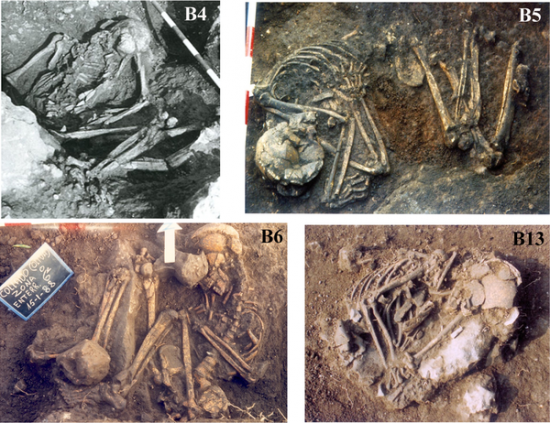Juan F. Gibaja, M. Eulàlia Subirà, nXavier Terradas, F. Javier Santos, Lidia Agulló, Isabel Gómez-Martínez, Florence Allièse, Javier Fernández-López de Pablo
Source - http://journals.plos.org/plosone/article?id=10.1371/journal.pone.0115505

Photographs of Graves 4, 5, 6 and 13 in El Collado cemetery. doi:10.1371/journal.pone.0115505.g003
Abstract
Located on the Iberian Mediterranean coast, El Collado is an open-air site where a rescue excavation was conducted over two seasons in 1987 and 1988. The archaeological work excavated a surface area of 143m2 where 14 burials were discovered, providing skeletal remains from 15 individuals. We have obtained AMS dates for 10 of the 15 individuals by means of the direct dating of human bones. The ranges of the probability distribution of the calibrated dates suggest that the cemetery was used during a long period of time (781–1020 years at a probability of 95.4%). The new dates consequently set back the chrono-cultural attribution of the cemetery from the initial proposal of Late Mesolithic to an older date in the Early Mesolithic. Therefore, El Collado becomes the oldest known cemetery in the Iberian Peninsula, earlier than the numerous Mesolithic funerary contexts documented on the Atlantic façade such as the Portuguese shell-middens in the Muge and Sado Estuaries or the funerary sites on the northern Iberian coast.

Location of the most important Mesolithic cemeteries with two or more individuals in a primary position.
1. El Collado, 2. Casa Corona, 3. Mas Nou, 4. Los Canes, 5. La Braña, 6–9. Muge Area (Cabeço da Amoreiras, Moita de Sebastião, Cabeço da Arruda, Cova de Onça), 10–12. Sado Area (Amoreiras, Arapouco, Cabeço do Pez), 13. Samouqueira. doi:10.1371/journal.pone.0115505.g001